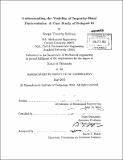Understanding the viability of impurity-band photovoltaics : a case study of S-doped Si
Author(s)
Sullivan, Joseph Timothy, Ph. D. Massachusetts Institute of Technology
DownloadFull printable version (17.78Mb)
Other Contributors
Massachusetts Institute of Technology. Department of Mechanical Engineering.
Advisor
Tonio Buonassisi.
Terms of use
Metadata
Show full item recordAbstract
This thesis explores the electronic structure, optical properties, and carrier lifetimes in silicon that is doped with sulfur beyond the equilibrium solid solubility limit, with a focus on applications as an absorber layer for an impurity-band photovoltaic device. The concept of an impurity-band material envisions the creation of a band of electronic states by incorporating high concentrations of deep-level dopants, which enable the generation of free carriers using photons with energy less than that of the band gap of the host semiconductor. The investigations reported in this thesis provide a framework for the appropriate selection of impurity-band candidate materials. The thesis is divided into three primary sections, one for each of three experimental techniques, respectively. First, the electronic band structure is studied using synchrotron-based x-ray emission spectroscopy. These spectra provide the first insights into how the electronic structure changes as the sulfur concentration is increased across the metal-insulator transition, and how the electronic structure is linked to the anomalously high subband gap absorption. A discrete change in local electronic structure is seen that corresponds to the macroscopic change in electronic behavior. Additionally, a direct correlation is seen between sulfur-induced states and the sub-band gap absorption. Next, the optical properties are studied using Fourier transform infrared spectroscopy. Extraction of the complex index of refraction is performed using numerical models that simulate both the transmission and reflection measurements. Analysis of the absorption coefficient determines the position of the sulfur-induced states within the band gap and their optical cross section for different sulfur concentrations and annealing conditions. At sulfur concentrations above the metal-insulator transition, the sulfur states become degenerate or near-degenerate with the conduction band, and such high concentrations are deemed to have an electronic structure unsuitable for an impurity-band photovoltaic material. Third, low-temperature photoconductivity experiments determine the mobility-lifetime product for carriers generated via sub-band gap photons. Combining both the FTIR optical results with the mobility-lifetime product measured from photoconductivity experiments provide the first empirical determination of the impurity-band figure of merit for sulfur-doped silicon. The figure of merit is found to be over an order of magnitude too low to be suitable as an impurity band absorber layer. Finally, in the conclusion, future directions and a predictive methodology for selecting new candidate impurity band materials that hold promise are discussed. The predictive methodology describes a simple way to estimate the figure of merit for super-saturated materials solely using literature values of the optical and electrical capture cross sections at dilute concentrations.
Description
Thesis (Ph. D.)--Massachusetts Institute of Technology, Dept. of Mechanical Engineering, 2013. Cataloged from PDF version of thesis. Includes bibliographical references (p. 137-149).
Date issued
2013Department
Massachusetts Institute of Technology. Department of Mechanical EngineeringPublisher
Massachusetts Institute of Technology
Keywords
Mechanical Engineering.